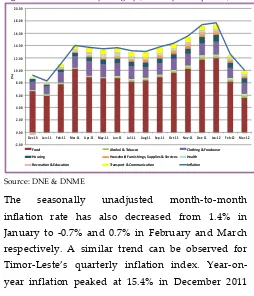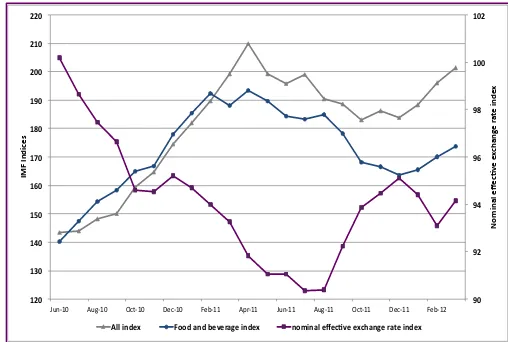National Directorate of Macroeconomics, DGPAR, Tel. +670‑333‑13‑37 Page 1 Timor‑Leste has seen a rapid increase in prices in 2011. To monitor inflation and analyse the underlying causes, the National Directorate of Macroeconomics (DNME) under the General Directorate of Policy Analysis and Research (DGPAR) of the Ministry of Finance (MoF) will publish a quarterly inflation review. This is the first review and embraces the first three months of 2012.
In Timor‑Leste, inflation is measured by the consumer price index (CPI), which is a measure of the cost of goods and services purchased by the average Timorese consumer. The National Directorate of Statistics (DNE), under DGPAR, collects the prices of these goods on a monthly basis for Dili and on a quarterly basis for Timor‑Leste.
Inflation Trend
Year‑on‑year inflation in Dili peaked in January at 17.7% and has fallen in subsequent months to 10% in March, the lowest rate since January 2011. As figure 1 shows, this can largely be traced back to the drop in food inflation, which makes up more than half of the CPI basket weight. With the exception of alcohol and tobacco, the drop in inflation can be observed across all groups.
Figure 1. Inflation in Dili by Category (Year‑on‑year, in percent)
Source: DNE & DNME
The seasonally unadjusted month‑to‑month
inflation rate has also decreased from 1.4% in January to ‑0.7% and 0.7% in February and March respectively. A similar trend can be observed for Timor‑Leste’s quarterly inflation index. Year‑on‑ year inflation peaked at 15.4% in December 2011
and dropped to 10.8% in March. With the exception of housing and recreation/education, this trend is consistent among all remaining categories. The largest quarter‑to‑quarter inflation increase was observed in the transport sector.
Figure 2 shows that lower inflation in the last quarter results from a slowing in price increases for both domestically produced and imported goods, which fell to 14.3% and 9.3% respectively. Since the first quarter of 2011 (Q1 2011), price increases for domestically produced goods have outstripped those of imported goods.
Figure 2. Timor‑Leste Imported and Local Product Prices (Year‑on‑
Year, in percent)
Source: DNE & DNME
!"#$$% $#$$% "#$$% &#$$% '#$$% (#$$% )$#$$% )"#$$% )&#$$% )'#$$% )(#$$% "$#$$%
*+,!)$% -./!))% 0+1!))%2.3!))%453!))% 2.6!))%-7/!))% -78!))% 479!))% :+5!))% ;,<!))%=>?!))% *+,!))% -./!)"% 0+1!)"%2.3!)"%
@AB%
0>>C% 48,>D>8%E%F>1.,,>% G8><DH/9%E%0>>CI+.3%
J>7KH/9% J>7K+D>8C%073/HKDH/9KL%:7558H+K%E%:+3?H,+K% J+.8<D%
M+,3+.N>/%E%OC7,.N>/% F3./K5>3<%E%G>PP7/H,.N>/% Q/R.N>/%
!"!#$ %"!#$ &"!#$ '"!#$ ("!#$ )!"!#$ )%"!#$ )&"!#$ )'"!#$ )("!#$ %!"!#$
*+,-!.$ /01-)!$ 234-)!$ 5+6-)!$ *+,-)!$ /01-))$ 234-))$ 5+6-))$ *+,-))$ /01-)%$ *78+9:,$;77<9$ =8671>+<$;77<9$ ?@871-A+9>+$BC=$
QUARTERLY INFLATION REVIEW
January – March 2012
National Directorate of Macroeconomics, DGPAR, Tel. +670‑333‑13‑37 Page 2
Underlying Causes
A MoF technical paper recently identified three main causes of high inflation in Timor‑Leste, namely international commodity prices, exchange rates, and government expenditure. This section will analyse how these factors may have contributed to the observed inflation trend in Q1 2012.
Figure 3 shows that the USD appreciated against Timor‑Leste’s main trading partners’ currencies in
As Timor‑Leste is a small open economy that is heavily reliant on imports, a fall of international commodity prices is likely to lower inflation once prices are passed on to domestic consumers. Especially the drop of international food prices will have had a dampening impact, as this
category carries a significant weight in the CPI basket. The appreciation/increase of the USD against Timor‑Leste’s trading partners’ currencies will also have had a deflationary impact, as the same amount of imports can be acquired at a relatively lower price when converted into USD. Empirical evidence from other countries suggests that both exchange rate changes and movements in international commodity prices are likely to have a lagged impact on domestic inflation and could therefore help to explain the fall in inflation in Q1 2012.
International factors explain why the increase in the prices of imported goods has slowed (Figure 2). They could also help to explain the widening gap between price increases of domestic and imported goods. But they cannot explain why the prices of domestic goods increased more slowly in Q1 2012 than in Q4 2011. A better rainy season may have
boosted agricultural production, improved
domestic supply and slowed domestic price increases. However, a 14.3% price increase is still relatively high. If domestic supply factors do not seem to explain these price increases, domestic demand may be the driving force. Past empirical evidence for Timor‑Leste suggests that increased government expenditure is one of the main contributors to domestic demand.
Inflation Prospects
Figure 3 shows that international commodity and food prices have been on the rise again since December 2011. Especially oil prices have increased rapidly. With pump prices in Timor‑ Leste directly reflecting international oil prices, this might partly explain why the transport category has already seen the highest inflation rates in the latest Dili and Timor‑Leste’s inflation index. Figure 3 also shows that, although
appreciating in March 2012, the USD depreciated with respect to Timor‑Leste’s main trading partners’ currencies in the first two months of 2012.
These developments are likely to put upward pressure on Timor‑Leste’s inflation in the next months.

